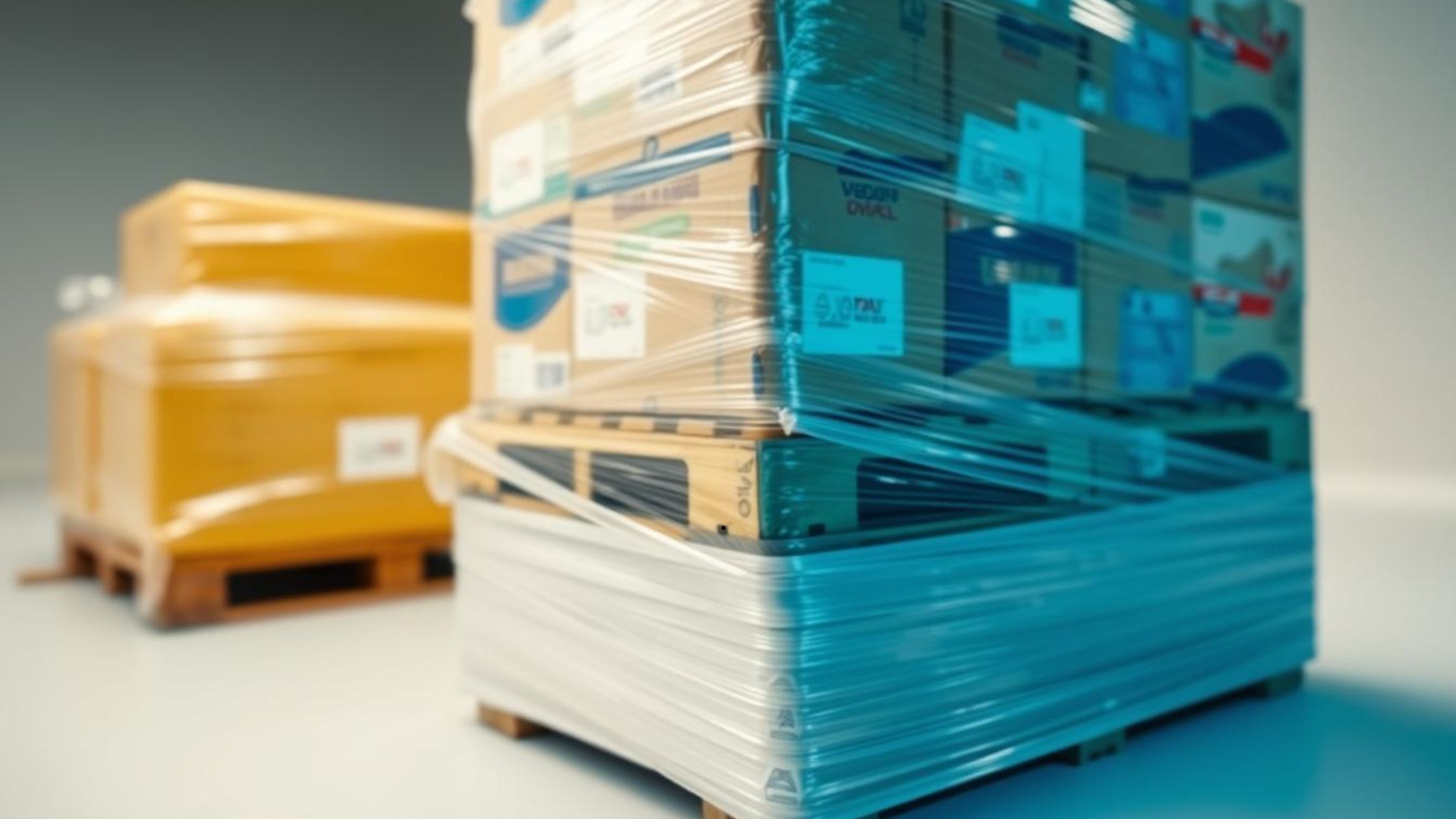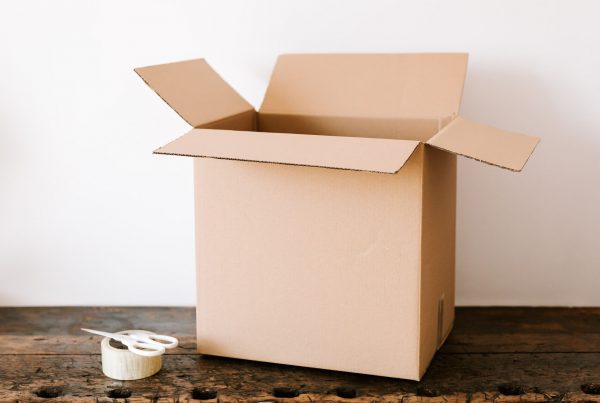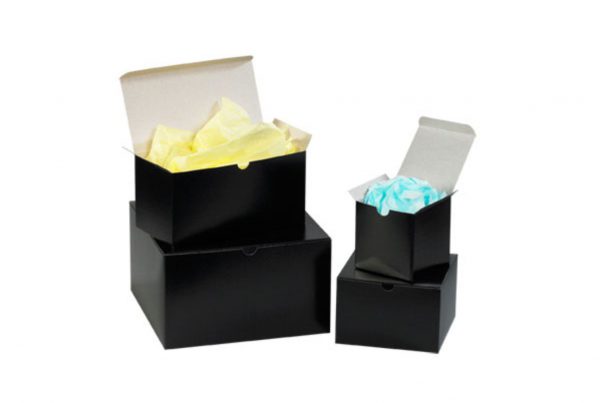Did you know that about 30% of all shipments get damaged during transit? That’s a crazy stat, right? Most of this damage comes down to sloppy packaging. If you’re shipping pallets, this should be a wake-up call to double-check your packing game. Using stretch wrap correctly can be a game-changer, ensuring your pallets arrive safely and sound.
This article is your go-to guide for applying stretch wrap film like a pro. We’ll walk you through the best techniques to level up your shipping and minimize those pesky transit issues.
Key Takeaways
- Stretch wrap is your best friend for keeping cargo secure during transport.
- Poor packaging is the primary cause of most shipping damage.
- Wrapping pallets with packing stretch film keeps them stable and protected.
- Proper techniques can seriously boost your shipping efficiency.
- Knowing your load inside and out is crucial for effective wrapping.
Understanding the Importance of Proper Stretch Wrapping
Ensuring your products arrive at their destination intact is the key to success. Proper stretch wrapping is a big piece of that puzzle. It locks items in place and shields them from bumps and bruises along the way.
When you nail the wrapping process, you’re not just making shipping safer—you’re making it more efficient. Fewer damaged goods mean happier customers and less stress for you.
Why Stretch Wrap Matters for Shipping
Stretch wrap is like a superhero for your pallets. It protects against dust, moisture, and other hazards that can wreak havoc. Its stretchy, clingy nature hugs items of all shapes and sizes, creating a tight, secure fit that lowers the risk of damage. Additionally, if you’re handling fragile items, consider pairing them with bubble wrapping for extra protection.
With the right package wrap, your shipments are ready to tackle the roughest journeys. Your products stay safe, and you get peace of mind.
Statistics on Shipping Damage
Shipping damage is a real headache for businesses. That 30% damage rate we mentioned? It’s a big deal. Items without proper wrapping—like shrink film or stretch wrap—are at even higher risk. By mastering stretch wrapping techniques, you can slash those risks and save your business from costly losses.
Assessing Your Load Before Wrapping
Before you even think about wrapping, you’ve got to size up your load. A little prep goes a long way to ensure your shipment arrives in tip-top shape. Knowing how to load pallets properly and getting accurate weight and size measurements is non-negotiable.
Optimal Pallet Loading Techniques
To keep your load stable and balanced, try these tips:
- Spread the weight evenly across the pallet to avoid tipping during transit.
- Use the interlocking method for boxes or packages to boost stability.
- Stack heavier items at the bottom and lighter ones on top—fundamental physics, but it works.
- Keep the load within the pallet’s limits to avoid overloading and ensure safe handling.
For extra security, consider using box bubble wrap for delicate items before wrapping the pallet.
Calculating Weight & Dimensions
Getting the weight and size right helps you pick the perfect amount of wrap. Here’s an example of how to break it down:
| Item | Weight (lbs) | Dimensions (LxWxH in) |
| Box 1 | 30 | 12x12x12 |
| Box 2 | 25 | 10x10x10 |
| Box 3 | 20 | 8x8x8 |
Add these numbers up, and you’ve got a clear picture of your load. This helps you decide how much packing stretch film you’ll need to keep everything secure.
Initial Setup for Stretch Wrapping
Starting on the right foot means choosing the right film and setting up your machine correctly. A little prep here saves a ton of hassle later.
Choosing the Right Stretch Wrap Film
Picking the right stretch wrap film is crucial. Consider the thickness, stretchability, and the needs of your load. Thicker films are ideal for heavy items, while more elastic ones are suitable for lighter loads. If you’re looking for alternatives, shrink film polyolefin is another solid option for specific applications. Your choice impacts both protection and wrapping speed.
Configuring the Stretch Wrapping Machine
Once you’ve got your film, it’s time to set up the machine. Input the load’s size and weight, then adjust the tension to match the film. Too tight, and you risk tearing; too loose, and it won’t hold. A well-configured machine saves time and keeps your items safe.
Step-by-Step Guide to Applying Stretch Wrap
Applying stretch wrap correctly can make your load virtually bulletproof during transit. Layering and tension are key. This guide will show you how to use packing stretch film to keep your shipment rock-solid.
Layering Techniques for Stability
First, ensure your pallet is loaded evenly and stable. When you start wrapping, layering is everything. Here’s the playbook:
- Begin at the bottom, wrapping the film around the pallet’s base two to three times for a sturdy foundation.
- Work your way up, overlapping each layer by at least 50%. This keeps the load tight and prevents shifting.
- For tall loads, add extra layers to the top half, focusing on securing edges and corners.
If you’re wrapping irregularly shaped items, you may also want to consider using brown wrapping for added protection before applying stretch wrap.
Ensuring Tension and Coverage
Tension is the secret sauce. Too little, and the film sags; too much, and it tears. Here’s how to nail it:
- Wrap tightly, but avoid overdoing it. Steady, even tension maintains the load’s stability.
- Cover all sides of the pallet, including the base, to secure everything in place.
- Secure the final layer to the pallet to prevent unwinding during shipping.
How Much Stretch Wrap Do You Need?
Figuring out how much stretch wrap film you need depends on several factors, including the pallet’s height, width, and the fragility of the items. This ensures your pallets are wrapped just right for safe travels.
Determining the Right Amount of Film
Start by measuring the dimensions of your pallet. Taller pallets require more wrap to cover the entire surface. Fragile items might require extra layers for safety. Here’s a quick formula:
- Calculate the perimeter: (Height + Width) x 2
- Multiply by the number of layers based on load stability
- Add extra for overlaps and securing the top
Understanding Pre-Stretched vs. Non-Pre-Stretched Wrap
Choosing between pre-stretched and non-pre-stretched wrap matters. Pre-stretched wrap offers better stability and uses less film, making it ideal for fragile or unstable loads. Non-pre-stretched wrap is more versatile and budget-friendly, perfect for general shipping. Here’s a quick comparison:
| Type of Wrap | Benefits | Best Use Case | Price Range |
| Pre-Stretched Wrap | Better stability, less film usage | Fragile or unstable loads | Higher |
| Non-Pre-Stretched Wrap | Versatile, cost-effective | General-purpose shipping | Lower |
For specific needs, you might also explore shrink film paper as an alternative wrapping option.
Final Adjustments and Quality Control
Once your load is wrapped, it’s time for some final tweaks to ensure it’s ready for the road. Quality control is the process of identifying and resolving issues before they become problems.
Securing the Load to the Pallet
A secure load is a safe load. Make sure the wrapped load is tightly bound to the pallet by:
- Adding extra stretch wrap at the base for a firmer grip.
- Using corner boards to maintain the load’s shape and protect edges.
- Ensure the wrap covers enough to prevent slipping during transit.
A balanced load is less likely to shift, which is critical for safe shipping.
Visual Checks for Overall Stability
Visual checks are your last line of defense. Here’s how to do them right:
- Look for loose ends or uneven wrap sections.
- Check that corners and edges are fully covered.
- Give the load a gentle shake—it should feel solid, not wobbly.
Thorough checks catch problems before your shipment hits the road, making your process more reliable and efficient.
| Method | Description | Benefits |
| Layering Wrap | Applying multiple layers of stretch wrap | Increases stability, reduces movement |
| Corner Boards | Using corner boards for protection | Maintains load shape, prevents damage |
| Visual Checks | Thorough inspection of wrapped loads | Identifies issues before shipping |
Conclusion
Mastering stretch wrapping is your ticket to safer, smoother shipments. This guide outlines the key steps to keep your pallets secure, from selecting the right stretch wrap film to performing those final checks. By following these tips, you can reduce damage risks and streamline your shipping process.
Excellent packaging doesn’t just protect your goods—it makes your customers happier and your business more efficient. Give these techniques a shot and watch your shipping results improve.
About The Boxery
The Boxery is your one-stop shop for top-notch packaging solutions in the shipping supplies world. They’ve got everything from stretch wrap to bubble wrap to keep your shipments safe and secure.
Quality and customer satisfaction are at the heart of what The Boxery does. Their carefully curated supplies, like shrink film, are designed to meet your needs, whether you’re wrapping fragile items or securing pallets. With The Boxery, you can ship with confidence and focus on growing your business.
FAQ
What is stretch wrap, and how is it different from shrink film?
Stretch wrap is a highly elastic plastic film used to wrap items for shipping and storage tightly. Unlike shrink film, which tightens with heat, stretch wrap relies on its elasticity to stay secure.
Can I use stretch wrap for all types of products?
Stretch wrap works great for pallets and stable items, but it’s not a one-size-fits-all solution. Fragile items may require additional protection, such as box bubble wrap, or brown wrapping.
How do I know which type of stretch wrap film to use?
Choose stretch wrap film based on your load’s weight, environment, and weather exposure. Options such as shrink film, polyolefin, or standard stretch wrap vary in terms of strength and application.
Is there a difference between pre-stretched and non-pre-stretched wrap?
Yes! Pre-stretched wrap stretches further, offering better hold with less film. Non-pre-stretched wrap is more flexible but may require more effort. Both are great, depending on your needs and budget.
What should I do if my pallet is unstable after wrapping?
Check the tension and coverage of your packing stretch film. Rewrap if needed, focusing on loose spots. Ensure the load is balanced and evenly wrapped.
How can I calculate the amount of stretch wrap I need for my load?
Measure your pallet’s height and width, and consider the fragility of the items. Factor in the number of layers and extra wrap for overlaps or delicate goods.
What kind of quality checks should I perform after wrapping?
Inspect the load’s stability, ensure it’s tightly secured to the pallet, and check that the wrap is even and snug. This prevents damage during transit.





Recent Comments